Highlights from the Canadian Community Cookbook Collection (December 12, 2023 until February 2nd, 2024)
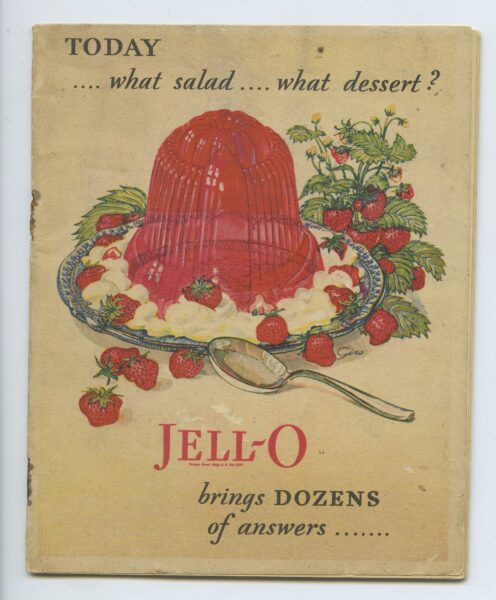
The Canadian Community Cookbook Collection contains over 250 community cookbooks, culinary textbooks, and company publications related to food products dating from 1888 to the early 2000s. It was donated to Special Collections in 2021 by Dr. Ian Mosby, a faculty member from TMU’s Department of History.
We are featuring an assortment of cookbooks in the Archives & Special Collections display cases to highlight the wide range of genres within culinary publications. We hope that these windows into Canadian culinary history, and especially the festive recipes, will inspire you to try making a new recipe, or watch the Great Canadian Baking Show during the winter break!
Explore more cookbooks from the collection on our blog post.
2022 Alcuin Awards for Book Design (November 7-29, 2023)
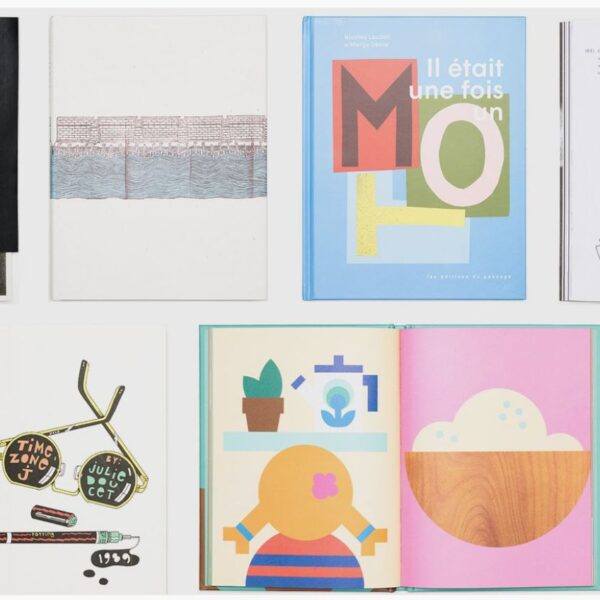
Since 1984, the Alcuin Society has recognized excellence in book design with a national awards program. The TMU Libraries are happy to showcase the award winners in nine trade book categories for the 2022 publishing period. The books will be on display in the exhibition window outside of the Archives & Special Collections (ASC), 4th Floor of the Library building, from November 7-29, 2023.
See The Alcuin Society’s website for a full list of the 35 winners.
LGBT History Month (October 10, 2023 – November 3, 2023)
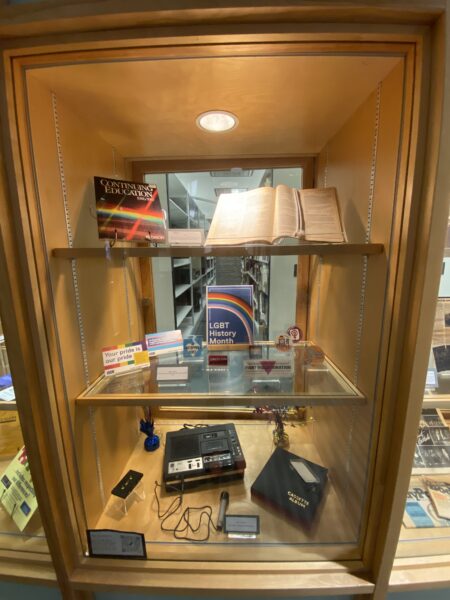
Explore the vibrant LGBTQ2S+ history of TMU! Our LGBT History Month display brings to life key moments in Pride history for the University and campus surrounding areas. Discover the aspiring stories of activism, unity and celebrations that have shaped our community, from the creation of TMU’s inaugural LGBT student group to the first North American conference dedicated to the recovery of LGBTQ2S+ histories held on campus!
Want a sneak peak? Listen to the 1992 Pride parade report by CKLN, TMU’s campus community radio station online.
Grant Collingwood Fonds (May 15, 2023 – September 22, 2023)
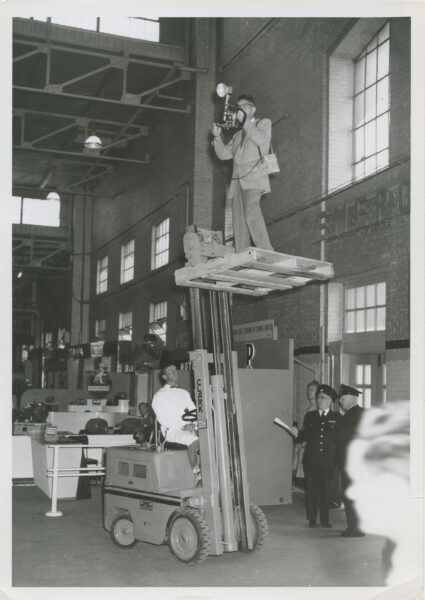
Introducing the Collingwood Fonds! This collection of 35 mm and 2 ¼ negatives, prints, and textual records was donated to the Archives & Special Collections in 2021 by a relative of the photographer, Grant Collingwood. As an avid photographer, he documented well-known jazz musicians, street views, buildings, events and local venues. He was also a commissioned photographer for numerous companies, namely the Mclean Hunter newsletter and Chatelaine magazine.
Thinking Inside the Box: Treasures from the Vault (June 26, 2019 – September 2, 2019)

TMU Archives is known for having historical papers and photographs – but did you know that they also have a large collection of artifacts and architectural remnants in all shapes and sizes? Special Collections is known for its photography based collections – but did you know that they also have Soviet propaganda, comic books and toys? Tying into our “Thinking Inside the Box” theme – this summer exhibit highlights a few of the lesser known artifacts we house in our vault
Thinking Inside the Box: Photography (May 1, 2019 – October 31, 2019)
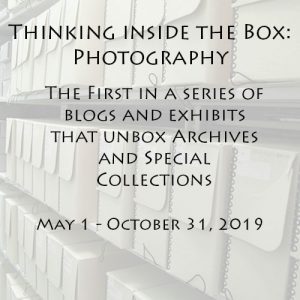
TMU Library’s Special Collections was founded in 2005 with the donation of the Kodak Canada Corporate Archive and Heritage Collection. Since this time, donations of photography and film-related materials have grown Special Collections exponentially, making up a major part of its holdings. Books, periodicals, photography and developing equipment are just some of the items we house. The camera collection boasts almost 800 cameras ranging in dates from the late 1860s to the early 2000s and include examples of miniature, instamatic, panoramic, and enlarging models. This exhibit highlights some of this fantastic collection – bringing them out of their boxes and putting them on display.
2018 First Edition Photobook Award Winners (November 19, 2018 – June 24, 2019)
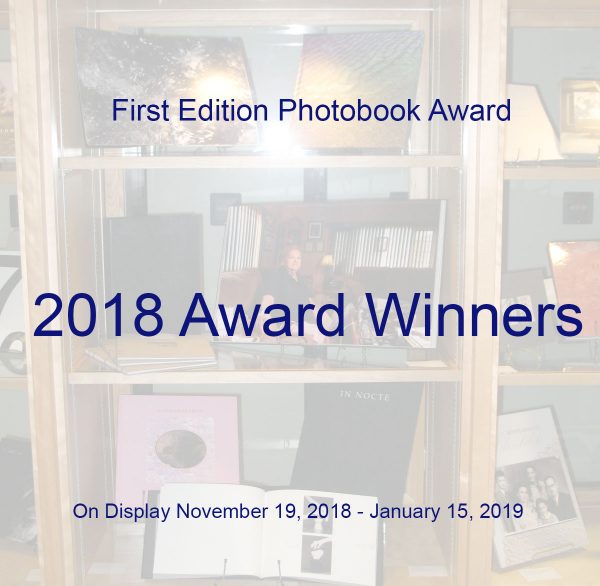
As part of the MPS507, a 3rd year Toronto Metropolitan University Image Arts class in the photographic book, students conceive of, and create their own photobook. This is, in part, related to work that has been completed in the co-requisite class, MPS506 – Photographic Production. These are both required courses for the Bachelor of Fine Arts (Image Arts) Photography Studies option. Each year the Library purchases the top photobooks in the class from the creator. The books are judged at the First Edition Photobook Show – an exhibition held at the end of the semester. They are catalogued by the Library and they are housed in Special Collections, where they are available for viewing. Read the blog for more information on the books
Ryerson 7025 (June 1, 2018 – October 31, 2018)
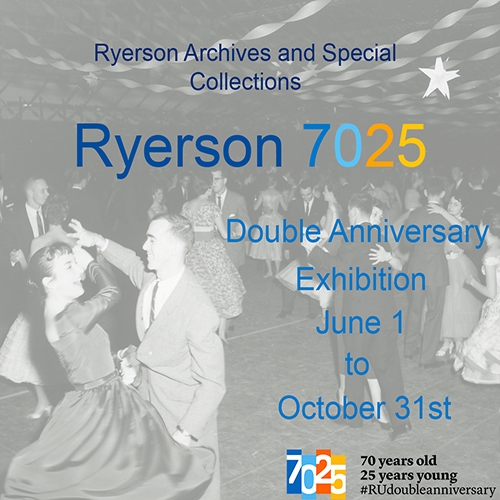
Come Celebrate Ryerson’s special double anniversary year – 70 years old and 25 years young. In conjunction with University wide celebrations, The Toronto Metropolitan University Archives has created an exhibit looking back at the history of the school. The exhibit is divided into 5 sections: 5 pivotal moments in Ryerson’s History; Student Groups and Clubs; Student Government; Student Housing, and Athletics and Intramurals. Visit the University’s anniversary website here
Projecting Magic (October 25, 2017 – December 31, 2017)
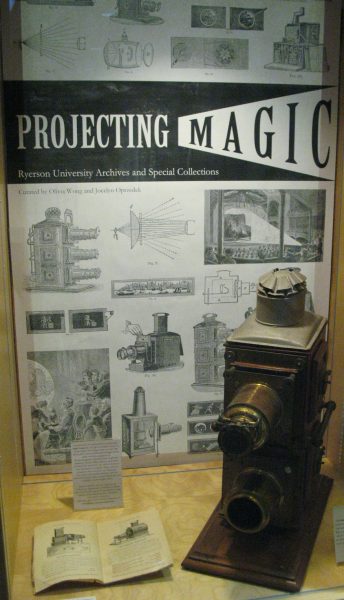
Highlighting the history of early optical projection and pre-cinematic technology. The exhibit features magic lantern projectors, hand painted lithographic and photographic glass slides from the John Tysall Magic Lantern Collection and the Lorne Shields Historical Photographic Collection. The exhibit is curated by Jocelyn Oprzedek and Olivia Wong. Learn more about the exhibit here
The Wellesley Hospital School of Nursing Alumnae Association collection (May 27, 2017 – December 31, 2017)
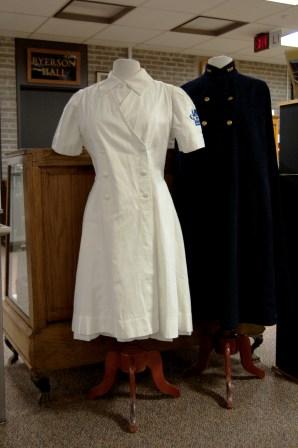
The Wellesley Hospital School of Nursing Alumnae Association collection of School, Hospital, and Alumnae Association Records. To search the collection please visit our database
Canada 150: Picturing the Canadian Landscape
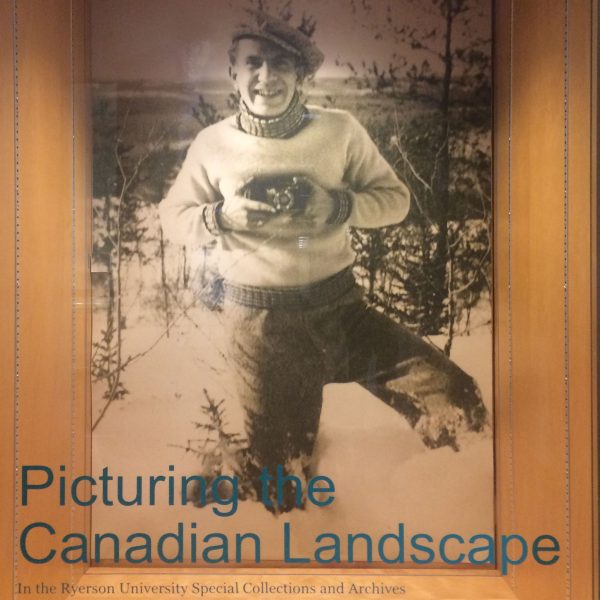
An exhibit of photographs, books, cameras, and ephemera from the Lorne Shields Historical Photograph Collection, the Heritage Camera collection, and the Kodak Canada Corporate Archives. The exhibit showcases Canada’s natural landscape and our interactions with it. Curated by Ryerson Image Arts students Bowie Fan, Gabriele Tai, Georgia Love, Justine Marasigan and Lodoe Laura. To learn more about the exhibit – read the blog post
Special Collections 10th Anniversary

2015 marked the 10th Anniversary of Special Collections at the Toronto Metropolitan University Library. It seems like a good time to have a look back at where we came from and where we are headed. Read more about it here
First Edition Book Award, 2015
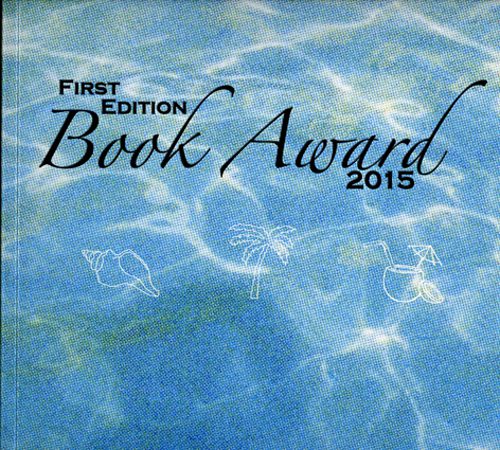
Students in the 3rd year of the Photography Program at Ryerson conceive of and create their own photobook featuring their original work. The books are judged at a year end exhibition and the top 5 books are purchased by the Library. We are thrilled to announce that 2015 marks the first annual awarding of the First Edition Book Awards, sponsored by Toronto Metropolitan University Library Special Collections. The awardees this year are Evan Hutchinson, Lodoe Laura, Lucy Lu, Emily Pleasance, Kristina Smith, Imogen Wallis-Mayer, and Rebecca Zynomirski. To learn more about books, see the blog.
Wellesley Hospital School of Nursing Alumnae Association 100th Anniversary (Summer 2015)

June 2015 marked the 100th Anniversary with the founding of the Wellesley Hospital School of Nursing Alumnae Association. To see what records we have in this collection please visit our database
Kodak in Toronto, 1899-2005: A Century of Traces (Spring 2015)
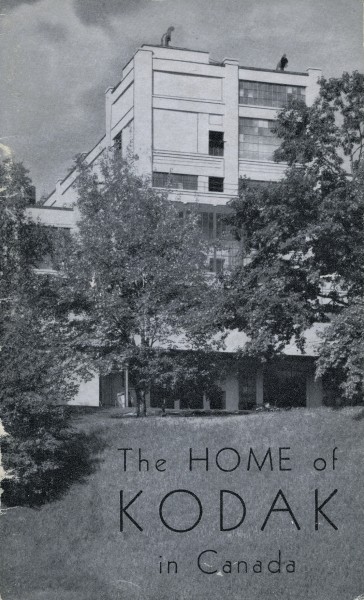
Over the course of its 106-year presence in Toronto, Kodak affected more than just the history of photography in Canada. In satisfying its need for cutting edge photographic manufacturing facilities, the company contributed several ambitious architectural projects to the cityscape. Through these contributions, Kodal left an indelible mark upon the city, from its turn of the century beginnings on Colborne Street, to the extensive complex in Mount Dennis, the traces of the Canadian branch of Kodak in Toronto are still visible today. This history was constructed from documents and artifacts from the Kodak Corporate Archives and Heritage Collections housed in Special Collections, search here. Read more about this exhibit in the blog
The Changing Campus – 66 Years of building Ryerson (Winter 2015)
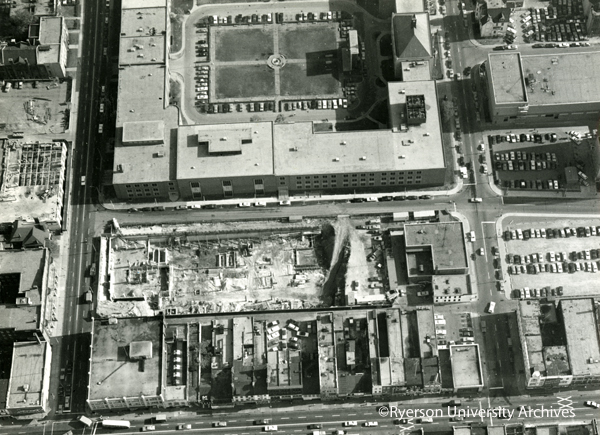
Ryerson’s Campus is a work in progress. Since the school’s inception in 1948, it has slowly increased its footprint in the downtown core through aquistion, demolition, renovation, and original construction. View photographs, an architectural model, and memorabilia documenting the construction of 6 of the buildings that make up Toronto Metropolitan University today. To read more about the exhibit – check out the blog. To learn more about Campus growth and construction, visit Facilities Management and Development’s website
#WIRED: A Digital History of Toronto Metropolitan University (January – March 2013)
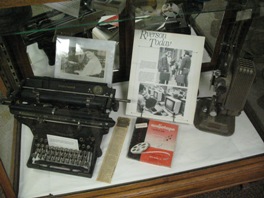
Toronto Metropolitan University began as a polytechnic institute devoted to the training of students in applied technology. This technical history has informed Ryerson’s identity and culture, playing a significant role in the way the University defines its relationship to the digital age. Bringing together diverse technological artifacts and historical materials from the Ryerson Archives, #WIRED is an exhibition that highlights pivotal moments in the digital evolution of Toronto Metropolitan University. Read more about the exhibit in the blog
Photojournalism: Tools of the Trade (October 2012 – January 2013)
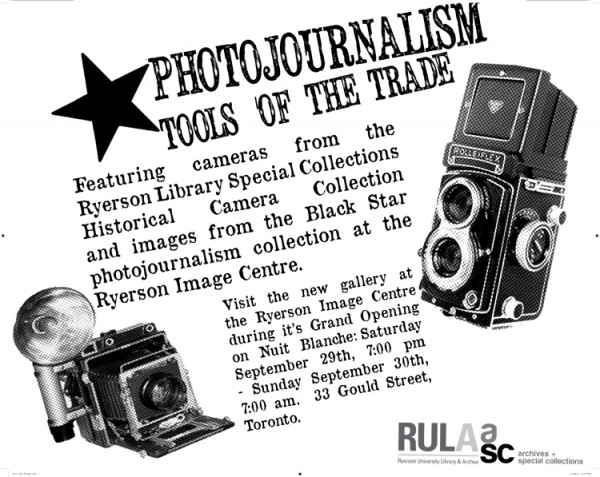
In recognition of the grand opening of the Ryerson Image Centre, Special Collections has put together a small exhibition featuring images of journalists from the Black Star collection with their cameras of choice and a selection of similar cameras from the Heritage Camera Collection in Special Collections. Read the blog for more information about his exhibit.
Early Cameras from the Wilhelm E. Nassau Camera Collection (February 21 – April 2, 2012)

From the camera obscura to the box brownie, the artifacts on display showcase the history of camera design in the 19th century. Recently acquired from Wilfred Laurier University, this is merely a fraction of the nearly 500 cameras donated. Read more about the exhibit in the blog.
A Model Practice: Photographs from the Canadian Architect magazine archive (January 4 – February 12, 2012)
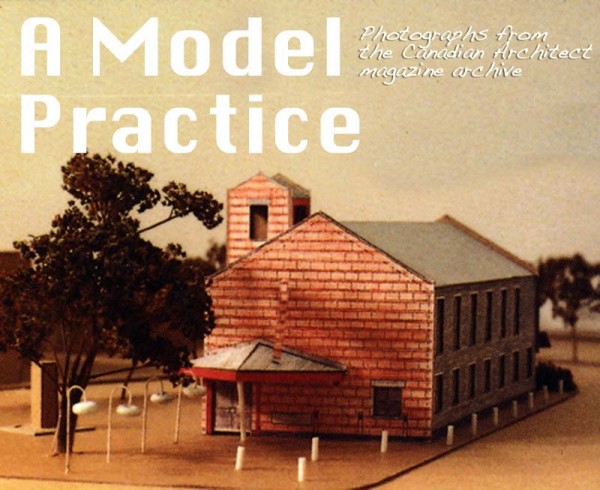
Photographs of models taken for Canadian Architect Magazine are on display in Special Collections on the Library’s 4th floor. These images were originally captured for project announcements, and today they give us as much to discuss as the finished buildings themselves. See the process that the architect goes through when bringing their idea to the public, and consider some of the challenges the architect faces in communicating with that audience. Here the idea of architecture is on display – judge for yourselves whether the real lives up to the imagined. Read our blog to learn more about this exhibit Search our database to see more from the Canadian Architect magazine fond
Alcuin Society Awards for Excellence in Book Design in Canada

The library is fortunate to host a traveling display of award-winning Canadian publications recognized by the Alcuin Society, a non-profit organization devoted to all aspects of books and reading. In order to promote an appreciation of fine books, the Society offers prestigious awards to Canadian book designers in several categories, all of which can be found in the display cases on the 2nd and 4th floors of the library. Among the titles on display are: Children’s book winner The Little Hummingbird by Michael Nicoll Yahgulanaas, designed by Jessica Sullivan and Naomi MacDougall and published by Greystone books; 1st prize Prose category winner I am a Japanese Writer by Dany Laferrière, designed by Peter Cocking and published by Douglas & McIntyre, and 1st prize Reference category winner The Conservation, Restoration, and Repair of Stringed Instruments and their Bows edited by Tom Wilder, designed by Emmelyne Pronillos and Laurie Castilloux-Bouchard, published by IPCI-Canada. For more information on the society, please visit the Alcuin Society website.
Canadian Fashion from the 60s, 70s and 80s (June 28 – August 15, 2011)
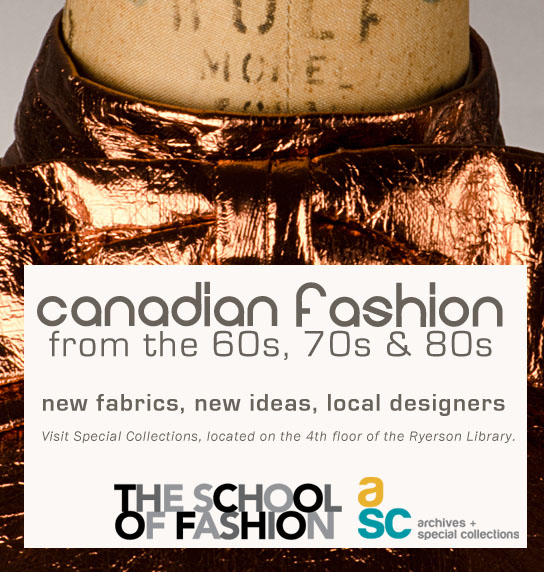
The dresses from the Fashion Research Collection each use an unexpected fabric to achieve a distinct look for each decade, whether it is the plasticized cloth of shiny copper 60s mini-dress, a silver lurex suit with multicoloured threads from the disco-influenced 70s, or the 100% silk power suit from the 80s. To learn more about the Fashion Research Collection – visit their website
Cameras from the Kodak Canada Collection (June 28 – August 15, 2011)
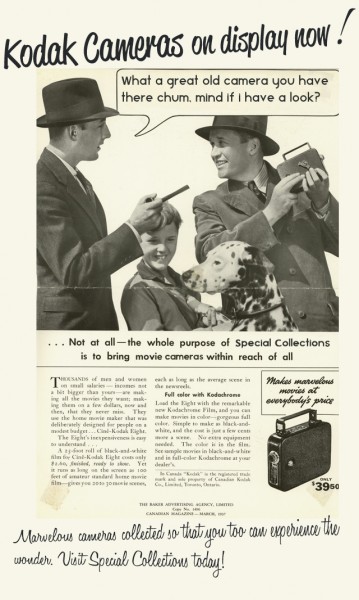
Taking a vacation this summer or just dreaming of one? Either way you can fantasize about the lovely pictures you’d take with one of the cameras on display in Special Collections. Visit our database to see what other cameras are in this collection.
Flora & Flutterbyes: Nature as inspiration and decoration (April 21 – June 27, 2011)
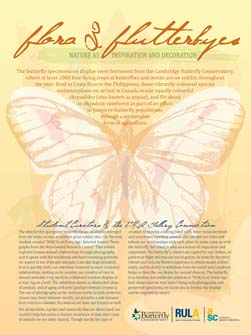
The butterfly specimens on display were borrowed from the Cambridge Butterfly Conservatory, where at least 2000 free-flying tropical butterflies and moths are on exhibit throughout the year. Bred in Costa Rica or the Philippines, these vibrantly coloured species metamorphose on arrival in Canada inside equally colourful chrysalides (also known as pupae), and flit about their business in an indoor rainforest as part of an effort to preserve butterfly populations through a sustainable form of agriculture. Here the offer us a fascinating look at the incredible variety of species in the wild. To learn more about the exhibit, visit our blog. For more about the Cambridge Butterfly Conservatory, visit their website
Raw Materials: Inuit Sculpture from the Sylvia A. Morley Collection (March 10 – April 17, 2011)

Special Collections received a donation of Inuit Sculpture from a former Ryerson student who actively collected, both through galleries in the Toronto area and in person at norther co-ops. The collection offers us an opportunity to discuss the use of raw materials from different regions, as she collected examples from across the Arctic (perhaps favouring Baffin Island and Labrador), and the growing art production within Inuit communities over the latter half of the 20th century. The display also precedes the opening of a much larger exhibition of contemporary Inuit Art scheduled to open at the Art Gallery of Ontario ‘Inuit Modern: The Samuel and Ester Sarick Collection. To learn more about the Special Collections exhibit visit our blog. To learn more about the AGO exhibit visit their web page
What’s on the Table: The Designer’s Response
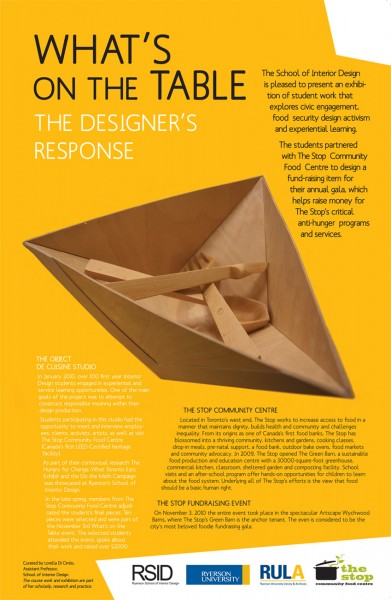
The School of Interior Design is please to present an exhibit of student work that explores civic engagment, food security, design activism and experiential learning. Student partnered wit The Stop Community Food Centre to design a fund-raising item for their annual gala, which helps raise money for The Stop’s critical anti-hunger programs and services. To learn more about the exhibit. visit our blog. To learn more about The Stop, visit their web site
Family Ties (February 2 – 22, 2011)
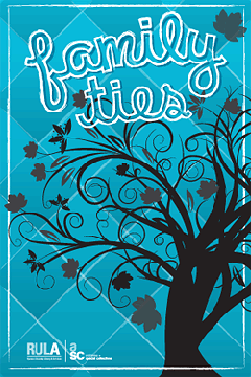
Words we use to express relationships change over time. Take the word “family”. Its meaning in the 21st century is very broad, referring just as often to single parent arrangements, step-parents and divorced parents, same-sex parents, cohabitating couples or independent children. Sometimes we think of our colleagues as forming our ‘work family’ or we call treasured family friends “aunt” or “uncle” when no blood relation exists. This is different from the early 20th century idea of a “nuclear family”, which referred only to two generations of the family living under one roof – two parents and child(ren). Around the 15th century, when the word first appeared in its Latin form familia, it referred only to the servants of a household (literally your “work family”!) This gradually broadened to mean the whole household, and eventually we see the emergence in the 17th century of the word “family” used to describe a group of related people, living inside or outside of the family home. How will “family” be defined in the future? Only time will tell, but it will probably be different..
Faces
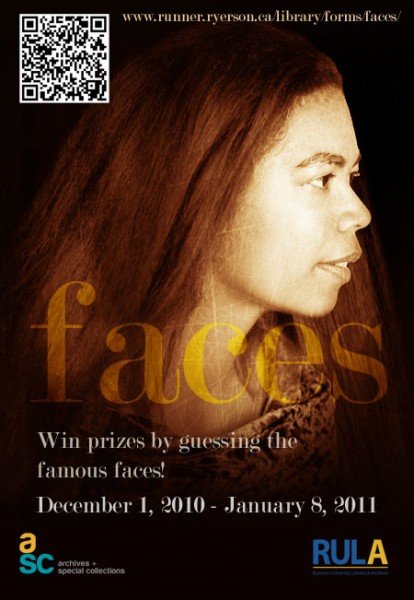
“FACES” took the place of our annual Holiday Photo Contest this year from December 1, 2010 – January 31, 2011. Participants were asked to play a guessing game with the famous faces on display, with a bonus prize awarded for guessing which Librarian posed for our poster (the answer is in our blog, if you’re curious). Names and faces were revealed on January 23rd with prizes awarded. Thanks to all those who played the game with us this holiday season!
Edwardian Fashion
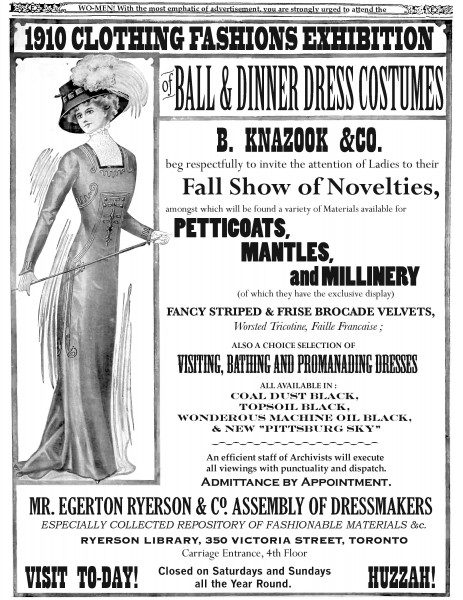
This exhibition focused on fashions from the 1910s and ran from October 20 – December 1, 2010. It celebrated the rich resource of historical costume in the Toronto Metropolitan University Fashion Research Collection, which holds a wide variety of men’s, women’s and children’s clothing from the 19th and 20th centuries. “Edwardian Fashion” focused on a period in fashion where elegant, floor-length gowns with corsets were still de rigueur for women’s day-wear, but the silhouette had slimmed down considerably from the puffed sleeves and bustles of 1905. We had to shorten the mannequin considerably to fit the collection’s black lace evening gown into the 4′ high display cases, but the photographs borrowed from the Special Collections Historical Photograph collection helped to illustrate how this type of gown was worn by women of the time.
Chemical Photography

From September 1 – October 19, 2010, Special Collections invited you over to the dark side …(of photography). We took you on a chemical tour of the darkroom, from the earliest days of photography, when image-making was a messy and sometimes dangerous business involving compounds of cyanide, mercury, lead, potassium and other toxic or flammable elements, to the Kodak years, when amateurs dropped their neat little rolls of film in the mail and let a professional do their dirty work. Not all photographers were content to let someone else develop their prints, but thankfully by the 20th century darkroom chemistry had standardized to the point where pre-mixed chemicals were readily available – along with health and safety manuals. On display were the artifacts of photography’s dangerous years in the darkroom. A History of Chemical Photography video from YouTube can be viewed here